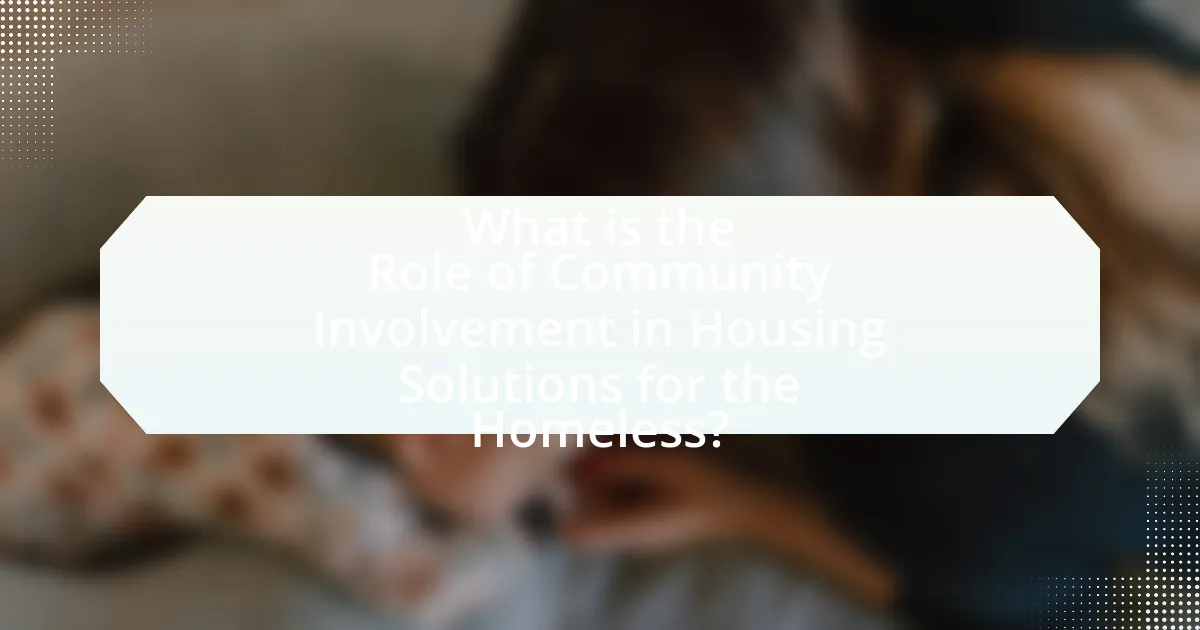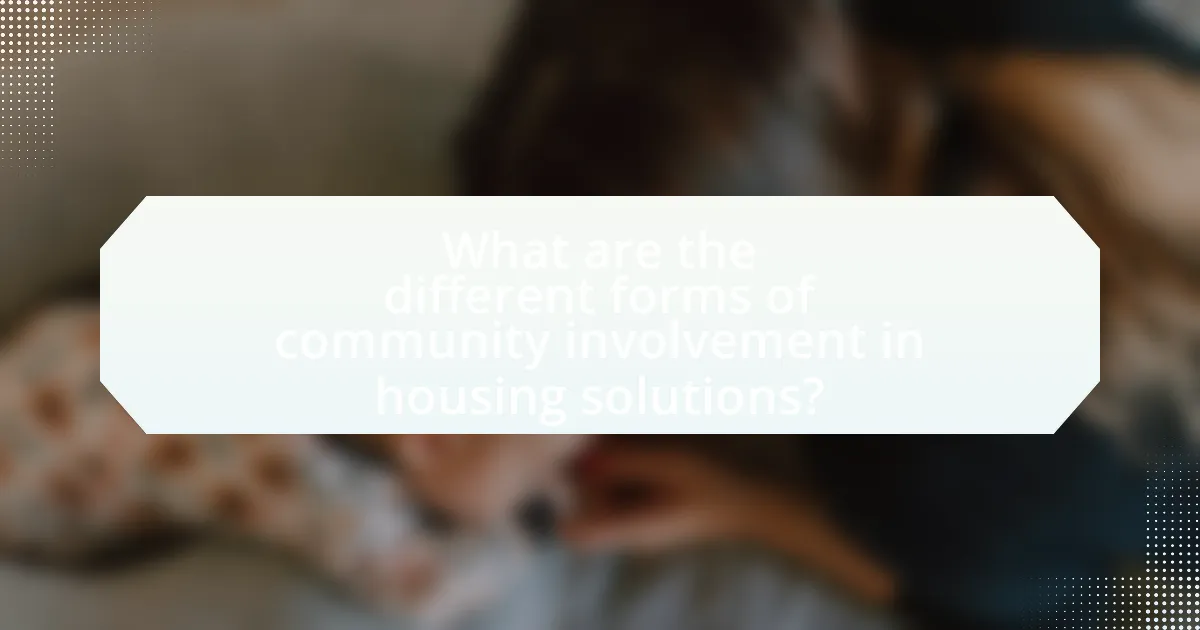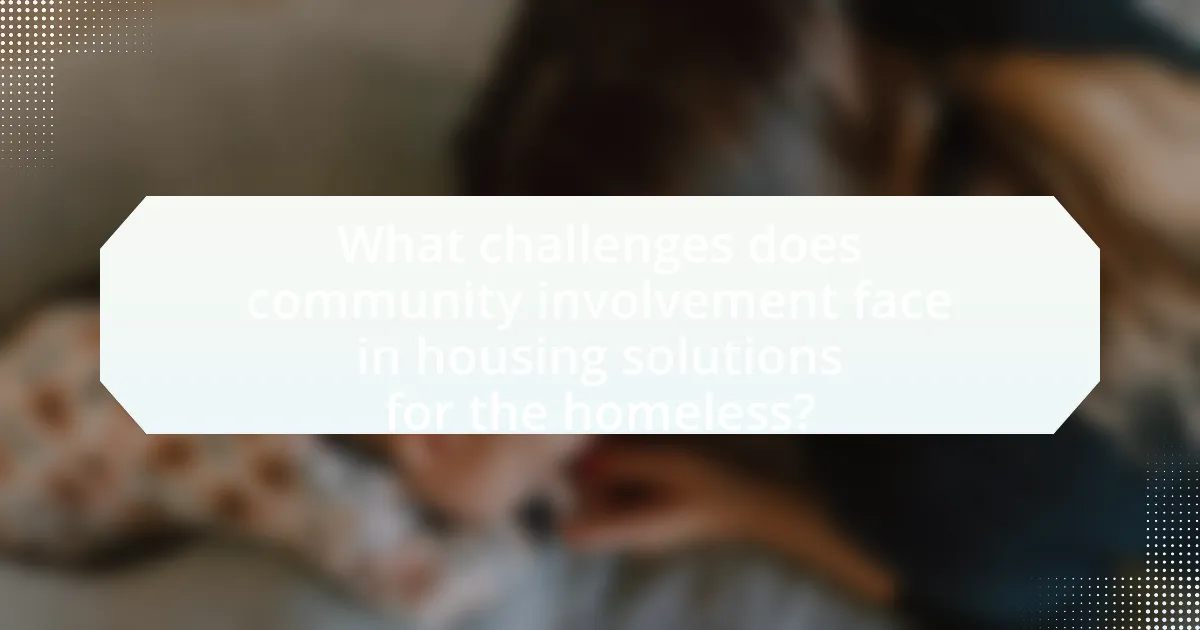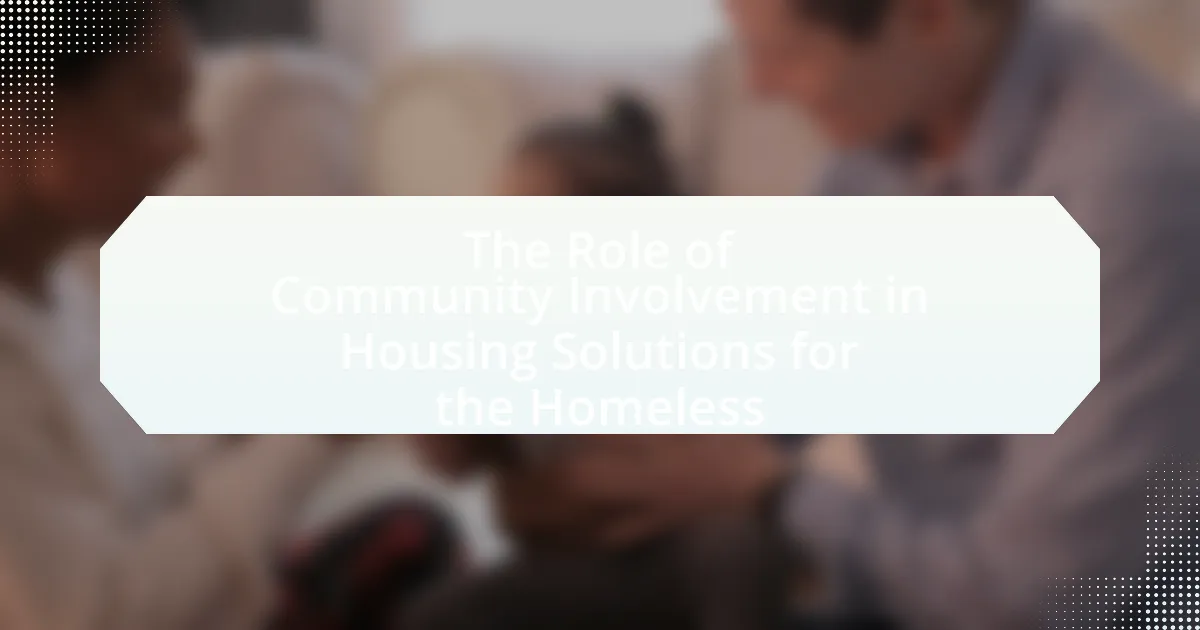The article focuses on the critical role of community involvement in developing effective housing solutions for the homeless. It highlights how local engagement fosters collaboration, resource sharing, and advocacy, leading to tailored interventions that address the specific needs of homeless individuals. Key elements of community involvement include partnerships among local organizations, resource mobilization, and advocacy efforts, which enhance the sustainability and effectiveness of housing programs. The article also discusses the varying levels of community engagement across different regions, the social benefits of active participation, and the challenges faced in mobilizing community support for housing initiatives.

What is the Role of Community Involvement in Housing Solutions for the Homeless?
Community involvement plays a crucial role in developing effective housing solutions for the homeless by fostering collaboration, resource sharing, and local engagement. Engaging community members allows for a better understanding of the specific needs and challenges faced by homeless individuals, leading to tailored solutions that address those issues. For instance, studies have shown that communities that actively participate in housing initiatives can increase the success rates of housing placements by up to 50%, as local support networks provide essential resources and social connections. Furthermore, community involvement can mobilize funding and volunteer efforts, enhancing the sustainability of housing programs.
How does community involvement impact housing solutions for the homeless?
Community involvement significantly enhances housing solutions for the homeless by fostering collaboration among local stakeholders, which leads to more effective and sustainable initiatives. Engaged communities can identify specific needs, mobilize resources, and advocate for policies that support affordable housing development. For instance, studies show that neighborhoods with active participation in housing projects often see a 30% increase in successful placements of homeless individuals into permanent housing. This collaborative approach not only addresses immediate housing needs but also builds social capital, creating a supportive environment that reduces the likelihood of homelessness recurrence.
What are the key elements of community involvement in this context?
The key elements of community involvement in housing solutions for the homeless include collaboration, resource mobilization, and advocacy. Collaboration involves partnerships between local organizations, government agencies, and community members to create comprehensive housing strategies. Resource mobilization refers to the gathering of financial, material, and human resources to support housing initiatives, which can include donations, volunteer efforts, and funding from local businesses. Advocacy focuses on raising awareness and influencing policy to address homelessness, ensuring that the needs of the homeless population are represented in decision-making processes. These elements are essential for developing effective and sustainable housing solutions that address the complexities of homelessness.
How does community involvement differ across various regions?
Community involvement in housing solutions for the homeless varies significantly across regions due to factors such as socioeconomic conditions, cultural attitudes, and local governance structures. For instance, urban areas often exhibit higher levels of organized community engagement, with numerous non-profit organizations and volunteer groups actively participating in initiatives, while rural regions may rely more on informal networks and local government support. A study by the Urban Institute highlights that cities with robust community organizations, like San Francisco, tend to implement more comprehensive housing solutions compared to regions with fewer resources, such as rural Appalachia, where community involvement is often limited by economic constraints and lower population density.
Why is community involvement essential for addressing homelessness?
Community involvement is essential for addressing homelessness because it fosters collaboration, resource sharing, and local support systems that are crucial for effective solutions. Engaging community members leads to a better understanding of the specific needs of homeless individuals, allowing for tailored interventions. For instance, studies show that communities with active participation in homelessness initiatives report higher success rates in providing sustainable housing and support services. According to the National Alliance to End Homelessness, local organizations and volunteers play a vital role in connecting homeless individuals with necessary resources, such as food, healthcare, and employment opportunities, which are critical for long-term stability.
What social benefits arise from community engagement in housing solutions?
Community engagement in housing solutions fosters social cohesion and enhances community resilience. When individuals participate in the development and implementation of housing initiatives, they build relationships and trust among diverse groups, leading to stronger social networks. Research indicates that communities with high levels of engagement experience lower crime rates and improved mental health outcomes, as residents feel a sense of belonging and responsibility towards their neighborhood. Additionally, collaborative efforts in housing projects often result in tailored solutions that better meet the specific needs of the community, thereby increasing the effectiveness of these initiatives.
How does community involvement enhance the effectiveness of housing programs?
Community involvement enhances the effectiveness of housing programs by fostering collaboration between stakeholders, which leads to tailored solutions that meet local needs. Engaging community members allows for the identification of specific challenges and resources, ensuring that housing initiatives are relevant and sustainable. Research indicates that programs with strong community participation see higher rates of success; for instance, a study by the Urban Institute found that community-driven housing projects resulted in a 30% increase in resident satisfaction and a 25% decrease in turnover rates. This evidence underscores the importance of community involvement in creating effective housing solutions.

What are the different forms of community involvement in housing solutions?
Community involvement in housing solutions encompasses various forms, including advocacy, volunteerism, financial contributions, and collaborative partnerships. Advocacy involves community members actively promoting policies and initiatives that support affordable housing, as seen in organizations like the National Low Income Housing Coalition, which lobbies for legislative changes. Volunteerism includes individuals participating in building or renovating homes through programs like Habitat for Humanity, which has engaged over 2 million volunteers since its inception. Financial contributions can come from community fundraising efforts or local businesses supporting housing projects, exemplified by community foundations that allocate grants for housing initiatives. Collaborative partnerships often involve local governments, non-profits, and community organizations working together to create comprehensive housing strategies, as demonstrated by the success of the “Home for Good” initiative in Los Angeles, which combines resources from multiple stakeholders to address homelessness effectively.
How do volunteer efforts contribute to housing solutions for the homeless?
Volunteer efforts significantly contribute to housing solutions for the homeless by providing essential labor, resources, and advocacy. Volunteers engage in activities such as building homes, renovating shelters, and organizing fundraising events, which directly increase the availability of housing options. For instance, organizations like Habitat for Humanity rely on volunteers to construct affordable housing, resulting in thousands of homes built across communities. Additionally, volunteers often raise awareness about homelessness, mobilizing community support and resources that can lead to policy changes and increased funding for housing initiatives. This collective action not only addresses immediate housing needs but also fosters long-term solutions through community engagement and empowerment.
What types of volunteer programs are most effective?
Effective volunteer programs for addressing homelessness typically include direct service initiatives, such as meal distribution and shelter support, as well as advocacy and awareness campaigns. Direct service programs provide immediate assistance and foster community engagement, while advocacy efforts mobilize resources and influence policy changes. Research indicates that programs combining these approaches yield higher success rates in improving housing stability and overall well-being for homeless individuals. For instance, a study by the National Alliance to End Homelessness found that comprehensive volunteer efforts that integrate direct support with advocacy lead to a 30% increase in successful housing placements.
How can individuals get involved in these volunteer efforts?
Individuals can get involved in volunteer efforts to support housing solutions for the homeless by participating in local organizations that focus on this issue. Many nonprofits and community groups offer opportunities such as serving meals, organizing donation drives, or assisting in building homes. For instance, Habitat for Humanity frequently seeks volunteers for construction projects, and local shelters often need help with administrative tasks or outreach programs. Engaging in these activities not only provides direct assistance but also raises awareness about homelessness in the community, fostering a more informed and compassionate public.
What role do local organizations play in community involvement?
Local organizations play a crucial role in community involvement by facilitating collaboration among residents, stakeholders, and service providers to address issues such as homelessness. These organizations often serve as a bridge, connecting individuals in need with resources, support services, and advocacy efforts. For instance, local nonprofits and community groups mobilize volunteers, organize events, and provide educational programs that raise awareness about homelessness and housing solutions. Research indicates that communities with active local organizations experience higher levels of civic engagement and more effective responses to social challenges, as evidenced by initiatives that have successfully reduced homelessness rates through coordinated efforts.
How do partnerships between organizations and communities enhance housing solutions?
Partnerships between organizations and communities enhance housing solutions by leveraging resources, expertise, and local knowledge to create more effective and sustainable housing initiatives. These collaborations enable organizations to access funding, technical assistance, and policy support while communities provide critical insights into local needs and preferences. For instance, a study by the Urban Institute found that community-driven housing projects are 30% more likely to succeed when supported by partnerships with local nonprofits and government agencies, demonstrating the effectiveness of collaborative approaches in addressing homelessness.
What are some successful examples of local organizations addressing homelessness?
Successful examples of local organizations addressing homelessness include the Coalition for the Homeless in New York City, which provides advocacy, services, and resources to over 3,000 individuals daily, and the Los Angeles Homeless Services Authority, which coordinates services for over 66,000 homeless individuals annually. These organizations have implemented effective programs such as permanent supportive housing and outreach services, leading to significant reductions in homelessness rates in their respective areas. For instance, the Coalition for the Homeless reported a 30% decrease in homelessness in New York City over a decade, demonstrating the impact of community-driven solutions.

What challenges does community involvement face in housing solutions for the homeless?
Community involvement in housing solutions for the homeless faces significant challenges, including lack of funding, resistance from local residents, and insufficient coordination among stakeholders. Funding shortages hinder the ability to implement and sustain housing projects, as many community initiatives rely on grants and donations that may not be consistently available. Resistance from local residents often manifests as NIMBYism (Not In My Backyard), where community members oppose the establishment of shelters or affordable housing in their neighborhoods due to perceived negative impacts. Additionally, the lack of coordination among various stakeholders, such as government agencies, non-profits, and community organizations, can lead to fragmented efforts that fail to address the comprehensive needs of the homeless population effectively. These challenges collectively impede the effectiveness of community involvement in creating sustainable housing solutions for the homeless.
What barriers hinder effective community participation?
Barriers that hinder effective community participation include lack of trust, insufficient resources, and inadequate communication. Lack of trust arises when community members feel their voices are not valued or heard, leading to disengagement. Insufficient resources, such as funding and manpower, limit the ability of communities to organize and participate in initiatives. Inadequate communication can create misunderstandings about goals and processes, further alienating community members. Research indicates that these barriers significantly impact the effectiveness of community involvement in addressing issues like homelessness, as highlighted in studies by the National Coalition for the Homeless, which emphasize the importance of trust and resource allocation in fostering participation.
How can communities overcome these barriers?
Communities can overcome barriers to housing solutions for the homeless by fostering collaboration among local organizations, government agencies, and residents. This collaboration can lead to the pooling of resources, sharing of best practices, and the development of comprehensive strategies that address the multifaceted nature of homelessness. For instance, the National Alliance to End Homelessness emphasizes that effective community engagement can result in tailored solutions that reflect the specific needs of the homeless population, thereby increasing the likelihood of successful outcomes. Additionally, implementing educational programs to raise awareness about homelessness can reduce stigma and encourage community support for initiatives aimed at providing housing and services.
What role does funding play in supporting community involvement?
Funding is essential in supporting community involvement by providing the necessary resources for programs and initiatives that engage residents in addressing homelessness. Financial support enables communities to organize events, facilitate training, and implement outreach efforts that encourage participation and collaboration among stakeholders. For instance, a study by the National Alliance to End Homelessness highlights that communities with adequate funding for outreach and engagement programs see a 30% increase in volunteer participation, demonstrating the direct correlation between funding and community involvement.
How can communities measure the impact of their involvement?
Communities can measure the impact of their involvement by utilizing quantitative and qualitative metrics such as surveys, data analysis, and case studies. For instance, tracking the number of individuals housed, the duration of homelessness reduced, and the improvement in community well-being can provide concrete evidence of effectiveness. Research conducted by the National Alliance to End Homelessness indicates that communities implementing targeted housing solutions have seen a 30% decrease in homelessness rates over five years, demonstrating the measurable impact of community involvement. Additionally, feedback from community members through focus groups can offer insights into perceived changes and areas for improvement, further validating the impact of their efforts.
What metrics are used to assess the effectiveness of community-driven housing solutions?
Metrics used to assess the effectiveness of community-driven housing solutions include housing stability, cost-effectiveness, community engagement levels, and resident satisfaction. Housing stability is measured by the percentage of individuals who remain housed over time, indicating the solution’s success in providing long-term accommodation. Cost-effectiveness is evaluated by comparing the costs of community-driven solutions to traditional housing methods, often showing that community initiatives can reduce overall expenditures. Community engagement levels are assessed through participation rates in planning and decision-making processes, reflecting the extent of local involvement. Resident satisfaction is gauged through surveys that capture the experiences and perceptions of those housed, providing insight into the quality of life improvements resulting from these solutions. These metrics collectively provide a comprehensive view of the impact and effectiveness of community-driven housing initiatives.
How can feedback from the homeless population inform community efforts?
Feedback from the homeless population can inform community efforts by providing direct insights into their needs, preferences, and barriers they face in accessing services. Engaging with this demographic allows community organizations to tailor programs and resources effectively, ensuring they address the specific challenges identified by those experiencing homelessness. For instance, studies have shown that when homeless individuals participate in program design, the resulting initiatives are more likely to succeed; a report by the National Alliance to End Homelessness highlights that programs incorporating client feedback see higher engagement and better outcomes. This evidence underscores the importance of integrating the voices of the homeless into community planning to create more effective and responsive housing solutions.
What best practices can enhance community involvement in housing solutions?
Best practices that can enhance community involvement in housing solutions include fostering partnerships between local governments, non-profits, and community members. Engaging residents in the planning process through workshops and public forums allows for diverse input and builds trust. Research shows that communities with active participation in housing initiatives see a 30% increase in project success rates, as evidenced by the National Community Development Association’s findings. Additionally, providing education on housing issues and resources empowers residents to advocate for their needs effectively.
How can communities foster a culture of collaboration and support?
Communities can foster a culture of collaboration and support by establishing inclusive platforms for dialogue and engagement among residents, local organizations, and stakeholders. These platforms, such as community forums and workshops, encourage participation and idea-sharing, which strengthens relationships and builds trust. Research indicates that communities with strong social networks are more effective in addressing local issues, including homelessness, as they can mobilize resources and support more efficiently. For instance, a study by the Urban Institute found that collaborative efforts in housing initiatives led to a 30% increase in successful placements for homeless individuals when community members actively participated in the planning and implementation processes.
What strategies can be implemented to sustain long-term community engagement?
To sustain long-term community engagement, strategies such as fostering inclusive participation, building strong partnerships, and providing ongoing education and resources should be implemented. Inclusive participation ensures that diverse community voices are heard, which enhances ownership and commitment to initiatives. Building strong partnerships with local organizations and stakeholders creates a network of support and resources, facilitating collaboration and shared goals. Ongoing education and resources empower community members with knowledge about homelessness issues and solutions, fostering a sense of responsibility and action. Research indicates that communities with active engagement strategies see a 30% increase in participation rates over time, demonstrating the effectiveness of these approaches in maintaining long-term involvement.

Leave a Reply